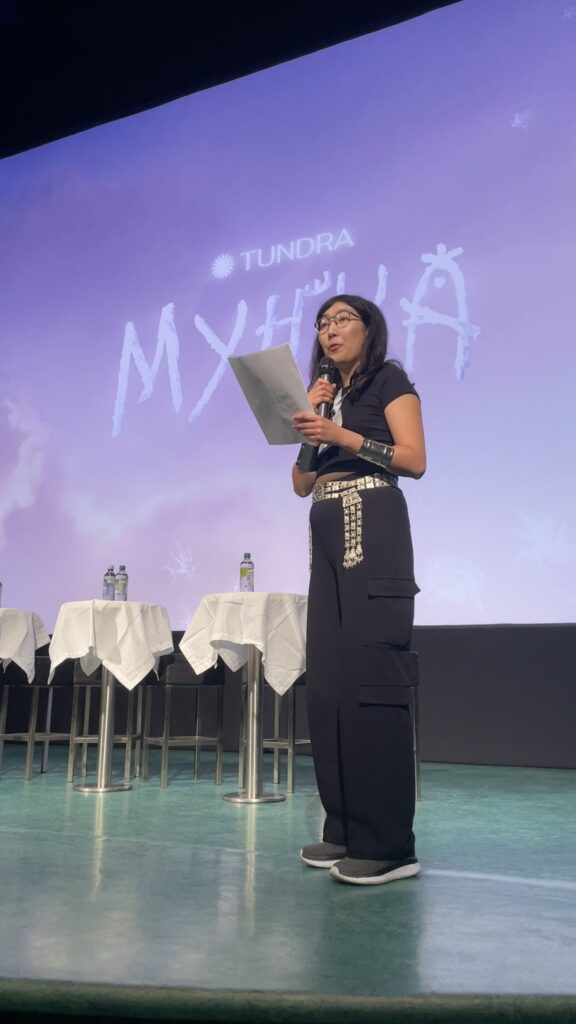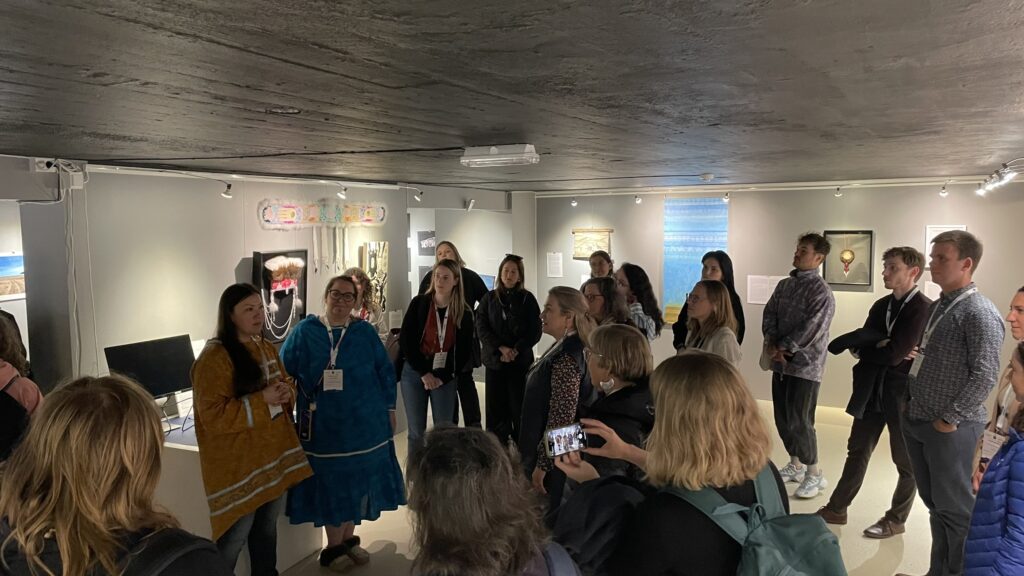Figure. Exhibition opening. Photo by Mariia Kuklina
CURATORS
Olga Zaslavskaya // Vera Kuklina // Tatiana Degai
ARTISTS
Andrey Adukanov // Aryuna Bulutova // Liudmila Gileva // Tatiana Khelol // Galina Koryakina // Ikuru Kuwajima // Ekaterina Lazareva // Yulia Levykina // Nikki Lindt // Beili Liu // Olga Lo // Mariana Marakhovskaia // Ekaterina Osipova-Mandukhaeva // Elena Rybina
// Alyona Savelyeva // Anastasia Savelyeva // Ekaterina Shramko // Kitrea Mai Pacifica Takata-Glushkoff // Oleg Zaporostky // Timur Zolotoev // Amber Webb
SCHOLARS
Jonathan Bobaljik // Jason Dobkowski // Friederike Gehrmann // Diana Khaziakhmetova // Alexander Kholodov // Dmitrii Kobylkin
// Natalia Krasnoshtanova // Stanislav Saas Ksenofontov // Mariia Kuklina // Andrey Petrov // Viktor Ryzhkov // Enh-Amgalan Sandag // Khadbaatar Sandag // Nikolay (Kolia) Shiklomanov // Haliehana Alagum Ayagaa Stepetin
Ice, snow, and permafrost are integral to Arctic human-landscape connections, providing shelter, water, and infrastructure, while also shaping identities and inspiring Arctic residents. Indigenous Peoples’ livelihoods deeply intertwine with frozen landscapes. They have developed diverse ways of interacting with and keeping knowledge about them, including through language, art, and subsistence practices. Deterioration of Arctic frozen environments driven by climate change impacts not only local and Indigenous communities but has the potential of affecting the whole of humanity. Complexity of problems the Arctic is facing today requires a search for new ways of discussing, understanding, and envisioning our relationship with land and water for now and for the future.
As part of the cultural program of the Arctic Congress, IASSA hosted a collaborative exhibition project that brought together diverse knowledge systems including scholarly expertise, artistic creativity, and Indigenous worldviews. The term “StoryWorlds” suggests multi-layered, interconnected narratives, illuminating various facets of Arctic life. “Frozen Matters” delves further than merely acknowledging the Arctic’s cold conditions; it signifies a deep understanding of its foundational elements. Through co-production and co-creation of knowledge approaches, scientific exploration, and research findings are integrated into multimedia displays. Artistic expressions infuse creativity into the space, prompting reflection on emotional and aesthetic responses to the changing Arctic landscapes. Indigenous cultures and worldviews are celebrated through the vibrant storytelling traditions transferred through generations of knowledge keepers and highlighted through Indigenous art forms.
Curators Olga Zaslavskaya, Vera Kuklina, and Tatiana Degai worked together with Indigenous and non-Indigenous artists and scholars from USA, Scandinavia, Europe, Siberia, and Mongolia to co-create installations through collaboration between three interdisciplinary initiatives. The NSF-funded interdisciplinary collaborative project “Frozen Commons: Change, Resilience, and Sustainability in the Arctic” (2021–2026) investigates the sustainability of frozen commons amid shifting environmental conditions, aiming to evaluate Arctic community resilience. Arts, Science, Local, and Indigenous Knowledge (ArtSLInK) is a digital transmedia platform to support various projects aimed at the convergence of diverse knowledge systems. Arctic Indigenous Virtual Artists Network (AIVAN) is an informal platform that unites Indigenous artists throughout the Arctic and beyond to share Indigenous visions of sustainability and observations of life in the Arctic through creative arts.
Collaboration between diverse forms of knowledge and representation varied throughout the exhibition. An example of collaborative work between scholars and Sakha artists is the installation Khaar kyyrpagha / Snowflake by Mariana Marakhovskaia, Stanislav Saas Ksenofontov, and Andrey Petrov which represents scholarly exploration of Sakha terminology related to different manifestations of Frozen Commons conceptualized and shaped by the artist as a snowflake. Meanwhile, Munkha a short film produced by Tundra Animation Studio as a celebration of the Sakha winter tradition of collective ice fishing for crucian carp, was screened in the local cinema to stimulate a dialogue between an audience and Sakha scholars Liudmila Nikanorova, Ekaterina Sofroneeva, and Galina Belolyubskaya about relations between ice, fish and culture in the Arctic. Very different exploration of ice was offered by artist Ekaterina Shramko in her work Atlas of Ice Forms. She presents a catalog and visual representation of the diverse array of natural ice formations by documenting the various shapes, structures, and textures that ice can take on across different environments and conditions and highlighting its importance in shaping landscapes, influencing climates, and supporting life.
Video narratives Arctic Fusion: Stories from the Frozen Lands and Waters unfold across the screens, transitioning between the perspectives of Indigenous storytellers, scientists, and artists, creating a rich and multi-layered tapestry of the Arctic’s cultures and environment. A series of sound installations provides an auditory experience that complements the visual images from different parts of the world’s cold places including artistic performance in Norway Arctic Mending/Snow Mandala by Beili Liu, dancing performance on Lake Baikal Reverence to the Feeling of Baikal by Kitrea Mai Pacifica Takata-Glushkoff, soundscape project in Alaska The Underground Sound Project: Arctic Portals by Nikki Lindt in collaboration with Arctic ecologists Jason Dobkowski and Friederike Gehrmann and video from travel to Northern Mongolia Blurry Roads: Journey on the Frozen Land and Water by Olga Lo. Another series is composed of stories made or told by Indigenous artists and knowledge holders, such as digital art LUSUUD by Buryat artist Aryuna Bulutova in collaboration with Timur Zolotoev exploring Buryat Shamanic Lusuud ceremony, honoring the water deity; the animated film Tuntu/ Caribou by Yulia Levykina and Amber Webb based on the story of a Yupiaq family witnessing the disappearance of caribou herds, symbolizing their ancestral ties to the land; and short animated film Kuŋarapu / My childhood by Alyona Savelyeva and Anastasia Savelyeva based on the works and stories by Galina Koriakina from the Even People.
A series of works of the exhibition are dedicated to Mongolia that is rarely associated with the Arctic. However, Mongolia ranks as the fifth country globally in terms of permafrost extent while experiencing climate warming 2.7% faster than the rest of the world. Similarities with the Arctic are especially evident in the Khövsgöl aimag, home for reindeer, yak and cattle herding communities with similar environmental and cultural forms as well as the common issues faced by communities. In the installations, the authors speculate and portray examples of daily practices and relationships with frozen matter that connect Indigenous and local communities with the Arctic. The works explore the various ways frozen commons are utilized in Mongolia. From providing access to drinking water and facilitating faster winter roads to enabling food storage and enhancing tourism opportunities, snow and ice play a multifaceted role in the daily life of ordinary people in Mongolia. Photos made by scholars and artists during the expeditions connect the region with Siberia and Alaska. On the 2024 expedition to Mongolia, scientists invited artist Olga Lo who created live sketches, collected stones demonstrating the geological features of the landscapes. Olga’s subsequent work in collaboration with researchers and local collaborators on “’Mongol Zurag’: Frozen Commons” inspired by the Mongolian painter Marzan Sharav depicts frozen commons’ role in the lives of local people. From the humbling sight of the expedition’s trusty off-road vehicle trapped in the snow, to the enchanting spectacle of a snow figure festival, each vignette captures the essence of real-life experiences and serves as a poignant reminder of the imminent threats posed by global warming.


Figure. Photos of frozen lands of Mongolia, Siberia, and Alaska. Photo by Tatiana Degai
Figure. Olga Lo. “Mongol Zurag”: Frozen Commons. Printed digital artwork, 84.1×118.9 cm, 2024
Another large series of works represents Indigenous Art Forms as Reflections on Frozen Commons. Indigenous art form is a form of art that stems from the holistic understanding of human and non-human relationships through creative storytelling. It is meant to bring Indigenous voices forward to speak about socio-environmental challenges, community well-being, justice and equality, success and failure, and offer lessons, advice, and guidance. Indigenous art forms provide a glimpse into the knowledge base and experiences of Arctic communities building a bridge of understanding across diverse knowledge systems. Stories skillfully crafted by Indigenous women seamlessly come together to celebrate the vibrant Arctic life and at the same time grieve the lost generations of knowledge holders, interrupted relations, and the rapidly melting ecosystem. In this section, we draw attention to how Indigenous creative storytelling depicts delicate understanding of plentiful states of Arctic waters including diverse qualities of snow, variable conditions of ice, and rapidly changing permafrost grounds. These stories were diligently gathered by generations of Indigenous hunters, reindeer herders, fishermen, berry and herb pickers, mothers, fathers, grandparents, great-grandparents… Depicting the essence of what it means to be a respectful and responsible citizen of the Arctic ecosystem, these artworks praise the beautiful Arctic lands and waters that are viewed by Indigenous Peoples not as wilderness and a hostile environment, but as a deeply loved home.
Polar Forget-me-Nots painting by Mariana Marakhovskaia presents construction of meanings and patterns of the cultural heritage of the Sakha people, whose traditions have been passed down through generations despite hardships. Buryat Yurts Under Snow by Ekaterina Osipova-Mandukhaeva in collaboration with Mariia Kuklina artwork not only captures a Buryat yurt during the winter season but also signifies cultural resurgence. Delicate works of Haliehana Alaĝum Ayagaa Stepetin Isx̂atim Qitxuu ama Chngatum Qasii / Grass Basket Bottoms and Sea Otter Stitches and Qiiĝam Aĝadaa / Grass Sun Medallion Necklace present the unique Unangax̂ grass basket weaving traditions and human-animal interconnected relationships s along with Unangax̂ relationality to place that informs survival and thriving in Unangam Tanangin, the Aleutian Islands of Alaska.


Figure 4. Tatiana Degai gives tour during exhibition. Photo by Olga Lo
Figure 5. Artists Amber Webb, Olga Lo, and Haliehana Stepetin. Photo by Tatiana Degai
Through the works titled Kzos / Awaiting Balakitga and Zavina-Kugagt’s Winter Headdress: A Symbol of Love and Nature’s Bounty Tatiana Degai along with her collaborators Viktor Ryzhkov, Jonathan Bobaljik, and Oleg Zaporotsky are telling an Itelmen creation story that highlights the beauty of Kamchatka land explaining the Itelmen relationships with snow. These stories invite viewers to immerse themselves in the timeless story of love, longing, and the enduring power of creation (Figure 4).

Figure. Artist Amber Webb in front of her artworks. Photo by Tatiana Degai
Four Generations of Ivoshyokh’s Bags presented by Elena Rybina tells a story of the importance of intergenerational knowledge transfer among Khanty People and the crucial role women play in safeguarding and sharing knowledge Four bags showcased at the exhibit were created with meticulous care to safeguard essential for sewing clothing and household items, reflecting the values and lifeways of nomadic reindeer herders of Khanty People. Amber Webb is presenting three works that highlight the importance of tuntu (caribou), traditional Yupik dance, and spiritual practices ifor Yupik people. Tuntu (Caribou), Nasqurrun – headdress, and Naqugun / Women’s Belt celebrate spirit and the sacred relationship between the Yupik people and the animals that sustain them. It also symbolizes mourning for having less tuntu a in the Aleknagik area and for losing much of Indigenous knowledge.
Мучгын лгеуттуяян’а / Our Home by Liudmila Gileva and Tatiana Khelol in collaboration with Tatiana Degai explores the dichotomy that comes in the diverse understanding behind the concepts of “home” that incorporate western and Indigenous ideas of what and how home is. Through presenting the Museum of Nadezhda Kaizevna Khelol the authors explain how the knowledge of the land can be brought back into place to Indigenize colonial environments and create a home space.

Figure. ArtSLInK zines. Photo by Vera Kuklina
ArtSLInK (Maga)Zine: Where Creativity Connects for Scholarly Exploration is the last but not the least important part of the exhibition. Zines presented here are considered tools designed to serve scholars and artists in their research for creatively organizing their initial findings into thematic narratives and communicating them with a broad audience. The following zines compose this section: Tur Imanna / Land of Snow. Subjective Map of Kamchatka Peninsula by Ekaterina Lazareva in collaboration with Andrey Adukanov; From overgrazed pasture to overbooked tourism? by Mariia Kuklina, Andrey Petrov and Vera Kuklina; Ice water by Mariia Kuklina, Olga Lo, Vera Kuklina; and ALASKALAND by Diana Khaziakhmetova and Olga Lo, and a booklet Халяа, тошин, харз, etc – how many words your language has for describing icings? by Vera Kuklina in collaboration with Mariia Kuklina, Olga Lo, Khadbaatar Sandag, Sandag Enkh-Amgalan, and Dmitrii Kobylkin.
Link to the online catalog: https://frozen-matters.com/





